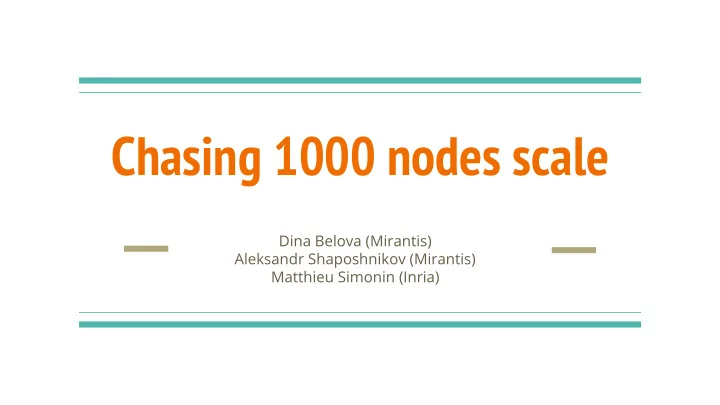

Chasing 1000 nodes scale Dina Belova (Mirantis) Aleksandr Shaposhnikov (Mirantis) Matthieu Simonin (Inria)
Who’s here? Dina Belova Matthieu Simonin Aleksandr Shaposhnikov
Agenda OpenStack Performance Team - who are we? ● What is 1000 nodes experiment about? ● Test environments ● Observations ● Lessons learnt ● Q&A ●
Performance Team Performance team: since Mitaka summit ● Part of Large Deployment Team ● Defining the performance testing and benchmarking methodologies on ● various scale Most common tools used: ● Control plane, density, dataplane and reliability OpenStack testing: Rally, Shaker, ○ os-faults Other tests: OSprofiler, sysbench, oslo.messaging simulator , other tools ○ Helping drive found solutions within OpenStack libraries and projects ● Focused on sharing knowledge community-wide ●
Performance Team Posting all data to Performance ● Docs http://docs.openstack.org/developer/ ○ performance-docs/ Sharing all tests we’ve run and all ● results for these experiments This data is used to improve ● OpenStack and underlying technologies as well as to choose best cloud topologies
1000 nodes experiment : what is it ? 1000 nodes = 1000 compute nodes ● Control plane speed/latencies/limits evaluation on scale ● Core underlying services evaluation (mysql,rabbitmq) for scale ● Study of ● the services resource consumption ○ potential bottlenecks ○ key configuration parameters ○ the influence of services topologies ○
1000 nodes: experiment methodology Deployment and Benchmark/Monitoring and Analysis tools Containers ● Simplifies CI/CD ○ Granularize services/dependencies ○ Flexible placement ○ Simplifies orchestration ○ cadvisor + collectd / influxdb / grafana ● Rally Benchmarks (boot-and-list instance scenario) ● Heka + ElasticSearch + Kibana ●
1000 nodes experiment : environments Mesos + Docker + Marathon as a platform for ~ 30 nodes with poweredge 2xE5-2630, 128GB ● ● Openstack (15 nodes with 2x , 256GB RAM, RAM, 200GB SSD + 3TB HDD (Grid’5000) 960GB SSD) Containerized OpenStack services (Mitaka release) ● Containerized OpenStack services (Liberty Augmented Kolla tool ● ● release) Use of fake drivers ● Modified Nova-Compute libvirt driver to skip ● run of qemu-kvm Code available : https://github.com/BeyondTheClouds/kolla-g5k
1000 nodes : experiment process Phase 1 Phase 2 Phase 3 Empty OS under load (Rally) Loaded / idle OS OS Boot and List Iterations = 20 K, concurrency = 50
1000 nodes : RabbitMQ (Empty OS)
1000 nodes : RabbitMQ (Empty OS) ● CPU / RAM / Connections Increase linearly with # Computes ● Connections : 15K with 1000 computes ● RAM : 12 GB with 1000 computes
1000 nodes: RabbitMQ (OS under load) (Phase 2) RabbitMQ load is big enough but tolerable, 20 Cores, 17 GB RAM ● (Phase 3) Idle load/Periodic tasks, 3-4 Cores, 16GB RAM. ● C O R E S R A M
1000 nodes : database (Empty OS) Database footprints are small even for 1000 computes 0.2 cores ● 600 MB RAM ● 170 opened connections ● Effect of periodic tasks for 1000 computes 500 select / second ● 150 update / second ●
1000 nodes : database (OS under load) Database (single node) behaves correctly under load ●
1000 nodes: nova-scheduler (OS under load) Rally benchmarks Nova API : n workers Scheduler : 1 worker only
1000 nodes: nova-conductor (OS under load) One of the most loaded service ● Periodic tasks could be pretty hungry for CPU resources (up to 30 cores) ● There is no idle time for conductor unless cloud is empty ● C O R E S R A M
1000 nodes: nova-api Under test load it consumes ~ 10 Cores; under critical load ~25 Cores ● Without load/Periodic tasks ~3-4 Cores ● Ram consumption is around 12-13GB ● C O R E S R A M
1000 nodes: neutron-server(api/rpc) Under test load consumption is ~ 30 Cores, under critical ~ 35 Cores ● Just adding new nodes ~ 20 Cores, Periodic tasks ~ 10-12 Cores ● C O R E S R A M
Conclusion 1. Default number of API/RPC workers in OpenStack services wouldn’t work for us if it tightened up to number of cores. 2. MySQL and RabbitMQ isn’t a bottleneck at all. At least in terms of CPU/RAM usage. Clustered one’s is an additional topic. 3. Scheduler performance/scalability issues.
Useful links 1000 nodes testing: ● http://docs.openstack.org/developer/performance-docs/test_plans/1000_nodes/plan.html#reports ○ Performance Working group ● Team info: https://wiki.openstack.org/wiki/Performance_Team ○ Performance docs: http://docs.openstack.org/developer/performance-docs/ ○ Weekly meetings at 15:30 UTC, Tuesdays, #openstack-performance IRC ● channel : https://wiki.openstack.org/wiki/Meetings/Performance Sessions this week: ● Today: OpenStack Scale and Performance Testing with Browbeat ○ (https://www.openstack.org/summit/barcelona-2016/summit-schedule/events/15279) Wednesday: Is OpenStack Neutron Production Ready for Large Scale Deployments? ○ (https://www.openstack.org/summit/barcelona-2016/summit-schedule/events/16046) Thursday: OpenStack Performance Team: What Has Been Done During Newton Cycle ○ and Ocata Planning (https://www.openstack.org/summit/barcelona-2016/summit-schedule/events/15504)
Q&A
Backup slides
OpenStack/Core services settings for 1000 scale Nova-api : database.max_pool_size = 50 Nova-conductor : conductor.workers by default is a number of cores so be careful if it’s too low Nova-scheduler : you have to run ~ 1 scheduler per 100 compute nodes Neutron-server : default.api_workers=100, default.rpc_workers=20 mysql/mariadb : max_connections = 10240 Linux : probably will have to tune ulimits,net.core.somaxconn,tx/rx queue on nics Haproxy : increase maxconns, timeouts
Grid’5000 Grid’5000 1000 physical nodes (8000 cores) ● 10 sites geographically distributed ● 10GB ethernet between sites ● http://www.grid5000.fr ●
Recommend
More recommend